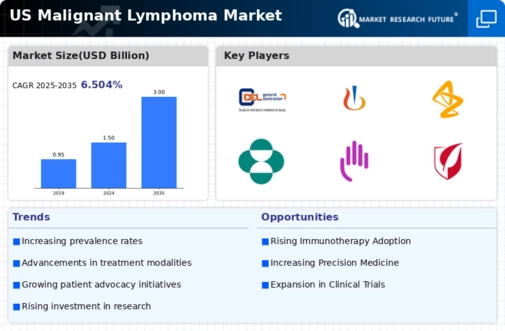The competitive landscape of the US Malignant Lymphoma Market is characterized by a dynamic interplay of innovation, strategic partnerships, and a growing emphasis on targeted therapies. Several pharmaceutical companies are actively vying for market share, with notable advancements in treatment options driven by clinical research and development. The increasing incidence of malignant lymphoma, alongside a greater understanding of its underlying biology, has amplified the urgency for effective treatments.
As a result, a plethora of products, ranging from monoclonal antibodies to combination therapies, has proliferated in the market, enhancing competition while broadening the therapeutic landscape for patients. Companies are leveraging technological advancements and engaging in collaborative initiatives to optimize their market presence and to fulfill unmet medical needs.
Celgene possesses a strong foothold in the US Malignant Lymphoma Market, bolstered by its robust portfolio of innovative therapies that address various subtypes of the disease. Its strengths lie in the development of targeted treatments that enhance patient outcomes and minimize side effects, offering a competitive edge in a crowded market. The company's focus on research and development has fostered a pipeline rich in possibilities, which allows it to adapt to changing treatment paradigms and patient needs.
Celgene's ability to leverage partnerships and collaborations in clinical trials has not only accelerated the development of new medicines but also reinforced its reputation as a leader in the field. This strategic positioning has resulted in a loyal customer base and increased market share within the US landscape of malignant lymphoma therapies.
Novartis also stands out in the US Malignant Lymphoma Market, recognized for its comprehensive range of treatment options and commitment to addressing the needs of this patient population. The company is known for key products that include advanced therapies tailored for treating different types of malignant lymphoma. Novartis has invested heavily in research and development, focusing on precision medicine and immunotherapy, which has paid off in terms of market presence and product acceptance.
Its strengths are further complemented by strategic mergers and acquisitions that have expanded its capabilities and portfolio in oncology. By integrating innovative solutions and enhancing drug accessibility, Novartis has established a strong position in the market. The company continues to pursue initiatives aimed at enhancing patient care, demonstrating its commitment to leading advancements in the treatment of malignant lymphoma within the US.
























